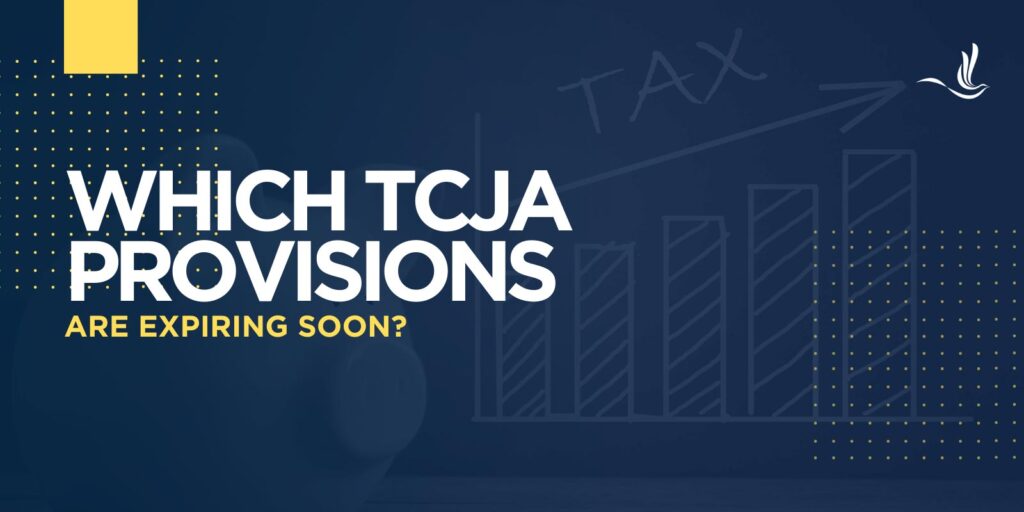
Since its enactment in 2017, the Tax Cuts and Jobs Act (TCJA) has significantly impacted the American tax landscape, introducing a slew of changes aimed at reducing tax burdens for individuals. However, many of these provisions were designed to sunset after a set period. Most are slated to expire in 2025. As this deadline approaches, it’s essential to examine the implications of these expiring provisions and how they might affect taxpayers across the nation.
Expiration of Individual Tax Provisions
Several key provisions of the TCJA affecting individual taxpayers are set to expire at the end of 2025.
Tax Brackets
The Tax Cuts and Jobs Act reduced the marginal tax rates across most individual tax brackets. But, once the sunset clause takes effect, these rates could revert to their prior levels.
| Taxable Income (Single filer in 2023) | TCJA Marginal Rate | Pre-TCJA Marginal Rate |
| $11,000 or less | 10% | 10% |
| $11,001 to $44,725 | 12% | 15% |
| $44,726 to $95,375 | 22% | 25% |
| $95,376 to $182,100 | 24% | 28% |
| $182,101 to $231,250 | 32% | 33% |
| $231,251 to $578,125 | 35% | 35% |
| $578,126 or more | 37% | 39.6% |
Standard Deductions
The TCJA nearly doubled the standard deduction, making it more advantageous for many taxpayers to take the standard deduction rather than itemizing deductions.
| 2017 (Pre-TCJA) | 2018 | 2024 | 2026 (Post-TCJA) | |
| Single Filer | $6,350 | $12,000 | $14,600 | Reverts Back |
| Married Filing Jointly | $12,700 | $24,000 | $29,200 | Reverts Back |
| Head of Household | $9,350 | $18,000 | $21,900 | Reverts Back |
Tax Credits
Certain tax credits changed after the TCJA was enacted. Here are some tax credit provisions that could expire in 2025.
- Child Tax Credit: Current at $2,000 per child. Prior to the TCJA, the credit was $1,000 per child. Single parents who earned more than $75,000 could only partially claim it. For married couples, this amount was $110,000. The TCJA increased these amounts to $200,000 and $400,000 respectively.
- Credit for Other Dependents: Taxpayers can claim $500 for each dependent that doesn’t qualify for the child tax credit.
Tax Deductions
If the TCJA is not extended or made permanent, there are several tax deductions that will revert to pre-TCJA figures.
- SALT Deduction: Currently capped at $10,000. However, a new proposal is aiming to raise this limit to $20,000 for married couples filing jointly who earn less than $500,000 for tax year 2023. Prior to the TCJA, there was no limit for the SALT deduction.
- Mortgage Interest Deduction: Prior to the TCJA, homeowners could deduct interest paid on mortgages of up to $1,000,000, or $500,000 for married couples filing separately. Under the TCJA, anyone who takes out a mortgage between December 15, 2017, and December 31, 2025, can only deduct interest paid on the first $750,000. This amount reduces to $375,000 for married taxpayers filing separately.
- Charitable Giving Deduction: You can currently deduct charitable contributions, up to 60% of your adjusted gross income. Once the TCJA sunsets, the cap will be 50% of your AGI.
- Medical Expense Deduction: Currently capped at 7.5% of adjusted gross income. Prior to the TCJA, the cap was 10% of AGI.
- Miscellaneous Deductions: The Tax Cuts and Jobs Act eliminated several miscellaneous deductions that were previously available. These include the cost of tax preparation, unreimbursed work expenses, moving expenses, and others.
Other Provisions
- Estate and Gift Tax Exemptions: Currently capped at $13.61 million per lifetime for individual filers and $27.22 million for married couples filing jointly. The projected amounts after the TCJA sunsets in 2026 are $7 million for single filers and $14 million for married couples filing jointly.
- 529 Plan Gifts: Under the TCJA, 529 Plans now cover up to $10,000 per year for K-12 tuition. Funds can also be used to pay student loan debt.
- Personal Exemptions: Prior to the TCJA, taxpayers could claim $4,050 for each personal exemption in addition to the standard deduction or their itemized deductions. The amount is now $0.
Uncertainty and Planning for the Future
The looming expiration of these TCJA provisions introduces uncertainty into the tax planning landscape for individuals. Taxpayers must consider the potential impact of these changes on their finances and prepare accordingly. For example, individuals may need to reassess their withholding allowances or adjust their financial strategies to mitigate any potential tax increases in the future.
Congressional Action and Potential Reforms
As the expiration date approaches, there is likely to be increased debate over the fate of the TCJA provisions. Lawmakers may consider various options, including extending certain provisions, making them permanent, or implementing alternative reforms to the tax code.
However, reaching consensus on tax policy can be challenging, particularly in a politically divided environment. Consequently, taxpayers should stay informed about developments in tax legislation and be prepared to adapt their plans accordingly.
Tax Help for Those Affected by the TCJA
The impending expiration of Tax Cuts and Jobs Act provisions in 2025 has significant implications for taxpayers across the United States. As these provisions sunset, individuals must navigate potential tax increases and plan accordingly. While the future of these provisions remains uncertain, staying informed and proactive can help taxpayers mitigate any adverse effects and optimize their financial strategies in the years to come. Optima Tax Relief is the nation’s leading tax resolution firm with over a decade of experience helping taxpayers with tough tax situations.
If You Need Tax Help, Contact Us Today for a Free Consultation